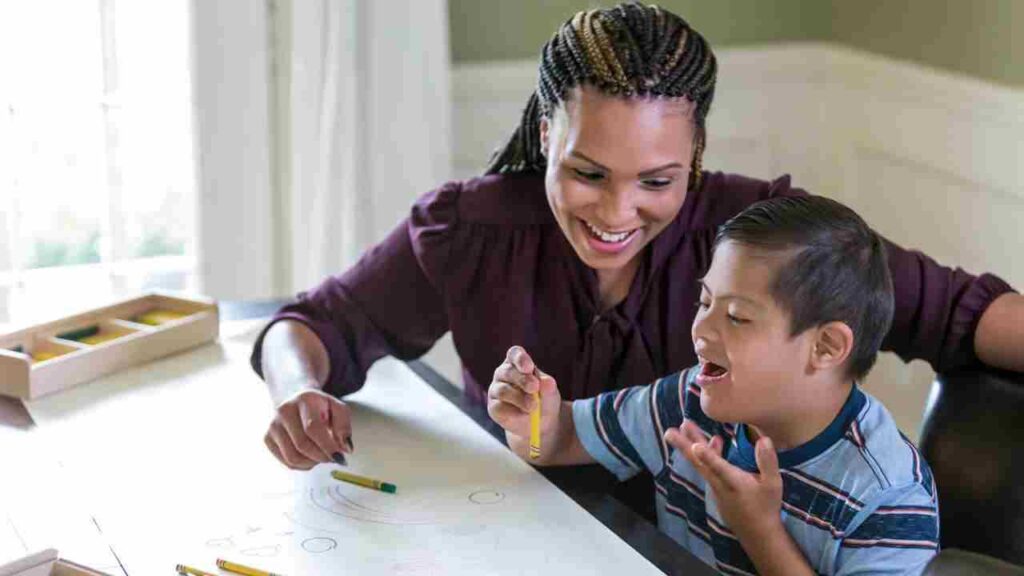Inclusive education is the cornerstone of a progressive society, ensuring that every child, regardless of their abilities, has the opportunity to thrive in the classroom. When it comes to children with disabilities, providing the right support and creating an inclusive environment can make a world of difference in their educational journey.
In this article, we will explore effective strategies and techniques to help children with disabilities thrive in the classroom.
What are Individual Needs

This understanding will help you tailor your teaching methods, accommodations, and interventions to meet each child’s specific requirements.
1. Foster a Supportive Environment
Creating a supportive and inclusive environment is vital for the success of children with disabilities. Encourage empathy, respect, and understanding among all students.
Teach them about different disabilities, emphasizing that everyone has unique strengths and abilities. Implement anti-bullying measures and promote a culture of acceptance, where all students feel valued and included.
2. Continuous Evaluation and Adaptation
Continuous evaluation and adaptation are essential in ensuring the effectiveness of strategies and interventions for children with disabilities. Regularly assess the impact of your teaching methods and accommodations. Seek feedback from students, parents, and colleagues.
Make adjustments as needed to better meet individual needs. Flexibility and a willingness to adapt will enable you to provide the best possible support for each child.
Read also: Support Children with Individualized Educational Requirements
3. Individualized Education Plans (IEPs)
Developing individualized education plans (IEPs) is a key component of supporting children with disabilities. IEPs outline specific goals, accommodations, and strategies tailored to each student’s needs.
Collaborate with parents, special education teachers, and therapists to create comprehensive IEPs that address academic, social, and emotional goals. Regularly review and update these plans to ensure they remain effective and relevant.
4. Differentiated Instruction
Implementing differentiated instruction techniques can greatly benefit children with disabilities. Adjust your teaching methods, materials, and assessments to accommodate diverse learning styles and abilities. Provide visual aids, hands-on activities, and auditory cues to engage different senses.
Use assistive technologies and adaptive equipment when necessary. Differentiated instruction ensures that each child can access and participate in the curriculum at their own pace and level.
5. Collaboration and Communication
Effective collaboration and communication among all stakeholders are essential for supporting children with disabilities. Regularly communicate with parents, therapists, and other professionals involved in the child’s care. Share progress, concerns, and strategies to ensure a consistent and coordinated approach.
Encourage open dialogue and actively seek feedback to continually improve the child’s learning experience.
Read also: Academic Accommodations for Children with Learning Disabilities
6. Sensory-Friendly Environment
Children with disabilities often have sensory sensitivities. Creating a sensory-friendly environment can help minimize distractions and support their learning. Consider the classroom layout, lighting, and noise levels. Provide sensory breaks, quiet spaces, and fidget tools to help children regulate their sensory input.
Being aware of and accommodating sensory needs can significantly enhance a child’s focus and engagement in the classroom.
7. Peer Support and Collaboration
Promoting peer support and collaboration benefits both children with disabilities and their classmates. Encourage cooperative learning activities, group projects, and buddy systems.
Pairing students with disabilities with their peers fosters friendships, empathy, and mutual learning. It helps create a sense of belonging and breaks down barriers, promoting a positive classroom dynamic.
8. Behavior Management Strategies
Children with disabilities may exhibit challenging behaviors due to their unique needs and frustrations. Implementing effective behavior management strategies is crucial to maintaining a positive and productive classroom environment.
Use positive reinforcement, clear expectations, and consistent consequences. Collaborate with the child’s support team to develop behavior intervention plans when necessary, ensuring a proactive and supportive approach.
Read also: Implementing Special Needs Education: Essential Strategies
9. Professional Development and Training
Continuous professional development and training are essential for educators to effectively support children with disabilities. Stay up to date with the latest research, teaching methods, and strategies related to inclusive education.
Attend workshops, conferences, and training sessions focused on special education. Engage in professional discussions, collaborate with colleagues, and seek mentorship opportunities. Enhancing your knowledge and skills will empower you to provide the best possible support for children with disabilities.
10. Assistive Technology
Integrating assistive technology into the classroom can be transformative for children with disabilities. Explore and implement various assistive devices and software that can enhance their learning experience.
For example, screen readers, speech-to-text software, and alternative input devices can help students with visual impairments or motor challenges. Assistive technology enables students to overcome barriers and actively participate in classroom activities.
11. Encourage Self-Advocacy
Empowering children with disabilities to become self-advocates is crucial for their long-term success. Teach them about their rights, strengths, and challenges. Encourage them to express their needs, ask for accommodations, and advocate for themselves in the classroom and beyond.
Foster a supportive environment where their voices are heard and respected. By developing self-advocacy skills, children can take ownership of their education and navigate challenges with confidence.
12. Celebrate Achievements
Recognize and celebrate the achievements of children with disabilities. Highlight their strengths, progress, and contributions in the classroom.
Showcase their work, display their accomplishments, and provide positive feedback. Celebrating their achievements boosts their self-esteem, motivates their continued growth, and fosters a positive learning environment for all students.
13. Professional Support Network
Building a professional support network is invaluable when it comes to helping children with disabilities thrive in the classroom. Connect with other educators, special education teachers, therapists, and support staff. Share ideas, resources, and best practices.
Collaborate on strategies and interventions. Having a strong support network allows for collective problem-solving and promotes a collaborative approach to inclusive education.
14. Parental Involvement
Active parental involvement is a key factor in supporting children with disabilities. Establish open lines of communication with parents, involving them in their child’s education. Regularly share progress updates, discuss goals, and seek parental input.
Collaborate on strategies to support learning at home and reinforce classroom teachings. By working together, educators and parents can create a cohesive support system that nurtures a child’s growth and development.
Read also: Special Education Classroom: Creating A Safe And Inclusive Environment
FAQs
Q1: What is inclusive education?
Inclusive education is an approach that ensures all students, including those with disabilities, receive a quality education in a supportive and inclusive environment.
Q2: How can teachers support students with disabilities?
Teachers can support students with disabilities by understanding their individual needs, using differentiated instruction, creating a supportive environment, and collaborating with parents and specialists.
Q3: What are individualized education plans (IEPs)?
Individualized education plans (IEPs) are personalized plans that outline goals, accommodations, and strategies for students with disabilities to support their learning and development.
Q4: What is assistive technology?
Assistive technology refers to devices, software, or equipment that helps individuals with disabilities overcome barriers and access educational materials or participate in activities.
Q5: How can inclusive classrooms benefit all students?
Inclusive classrooms benefit all students by promoting empathy, respect, and understanding, fostering diversity and collaboration, and creating a positive learning environment for everyone.
Conclusion
Creating an inclusive classroom environment where children with disabilities can thrive is a collective effort that requires understanding, empathy, and collaboration. By implementing the strategies discussed in this article, educators can create a supportive and enriching educational experience for all students. Remember, every child has unique strengths and abilities, and it is our responsibility to ensure that they are given the opportunity to reach their full potential.






